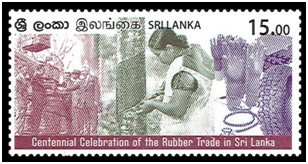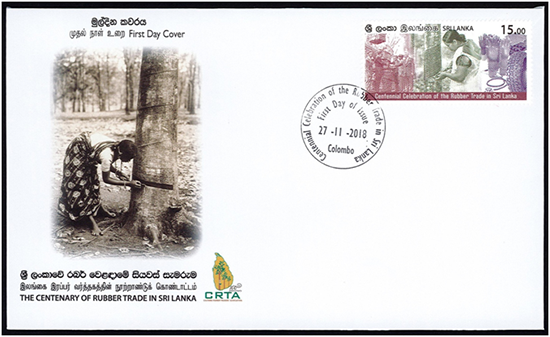

Home/Active Page

The Philatelic Bureau of the Department of Posts has issued a new postage stamp in the denominations of Rs. 15.00 on November 27, 2018 to mark the Centenary of Rubber industry in Sri Lanka.
| Date of Issue | 27th November, 2018 |
| Denomination | Rs.15.00 |
| Catalogue No: | CSL 2309 |
| Stamp Designer | Mevan Fonseka | Stamp Size: | 30mm x 60mm |
| Sheet Composition: | 20 stamps per sheet |

The Philatelic Bureau of the Department of Posts will issue a new postage stamp in the denominations of Rs. 15.00 on November 27, 2018 to mark the Centenary of Rubber industry in Sri Lanka.
The history of the rubber industry in the island of Ceylon, as Sri Lanka was then known, commenced in the year 1876, with the planting of almost 2,000 rubber seedling at the Gampaha Botanical Gardens. As in the case of the tea industry, it was one of the enduring colonial legacies left by the British, who not only contributed towards the expansion of this agricultural enterprise, but also helped create the complementary infrastructure, which continues to facilitate the supply chain of this thriving Industry.
For many decades, the tea, rubber and coconut industries, in that order of precedence, sustained the economy of the country. Rubber is Sri Lanka's second largest export-agriculture sector and still is a significant contributor to the economy, as the third largest export earner of the country.
With the rapid development of the industry, the oldest and largest Business Chamber of the country, the Ceylon Chamber of Commerce, created a Rubber Committee to look after the interests of the Rubber Trade in 1891. With its increasingly important role, it was eventually considered necessary to form a separate Association and on November 27th, 1918, the Colombo Rubber Traders' Association [CRTA] was inaugurated, as the premier forum for Rubber, under the founder Chairmanship of Mr. J. Lochore of Carson & Co. Ltd., and a Committee comprising buyers and sellers,. The brokers were invited to join the Association and to nominate a representative to serve on the Committee, some time thereafter. Many outstanding personalities of the Commercial Sector were present at the inaugural meeting and served on the Committee, as they have continued to do throughout the ensuing years.
Following almost three decades of exclusive European representation, in 1945, Mr. S.T.L. De Soysa of C.W. Mackie & Co. Ltd., was elected as the first Ceylonese member of the committee, representing buyers.
Over the years, the CRTA performed, and continues to perform, manifold noteworthy functions on behalf of the rubber industry, taking the lead in numerous initiatives that have enhanced value addition, ethical practices, environmental considerations and sustainability.
Although the first rubber auction was held in November 1910, 8 years before the formation of the CRTA, it took charge of the management and the conducting of the Rubber Auctions, ensuring its integrity and efficiency. During the years of the Second World War, the Rubber Auctions were suspended. The recommencement of the crepe rubber auctions took place in June 1950. Following the termination of the Rubber/Rice pact with the Peoples Republic of China, the first sheet rubber auction was held in April1981, whilst the first sale of latex rubber by Auction was held in January 1997.
The Colombo Rubber Traders' Association, having completed a successful and impactful 100 years of service to the industry, looks forward with optimism and confidence to the next 100 years.
All rights received. All right to identify the Department of Posts as the Author and designer of this Bulleting has been asserted in accordance with the Copyright, Design and Patents Act 1988.No part to this publication may be reproduced, stored in or introduced into a retrieval system, or transmitted in any form or by and means (electronic, mechanical, photocopying, recording or otherwise) without the prior permission from the publisher. Any person who does and unauthorized act in relation to this publication may be liable to criminal prosecution and civil claims for damages.